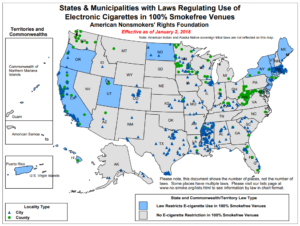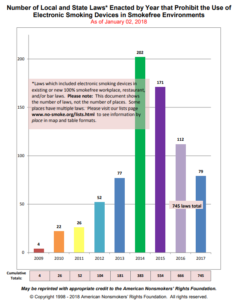Electronic, or e-cigarettes, are part of a category of products called Electronic Smoking Devices (ESDs), which are designed to mimic combustible tobacco cigarettes and, in most cases, contain varying levels of nicotine.1 Some products are marketed as nicotine-free devices; however, a 2009 study by the Food and Drug Administration (FDA) found trace levels of nicotine in products labeled as “nicotine free.”2 Currently, the constituents of e-cigarettes are not consistent across brands or within a single brand.3 The Family Smoking Prevention and Tobacco Control Act (Tobacco Control Act) of 2009 gives the FDA the authority to regulate the manufacture, distribution, and marketing of tobacco products to protect public health. E-cigarettes are included in the definition of tobacco products or product derived from tobacco.4 The Tobacco Control Act preserves the authority of state, local, and tribal governments to regulate tobacco products in certain specific respects such as the inclusion of e-cigarettes as products that cannot be used in smokefree environments.5 In August 2016, the first FDA regulations of e-cigarettes went into effect, including requiring a minimum age of sale of 18 years and prohibiting manufactures from making false or misleading claims about the safety of their products, while a requirement for e-cigarette manufacturers to disclose product ingredients will be phased in.
ESDs are relatively new products that require further study. The scientific evidence on the short-term and long-term health effects of the use of ESDs and exposure to ESD secondhand aerosol is growing, and the initial findings indicate there are risks associated with both use and exposure.6 The secondhand aerosol emitted from ESDs contains toxins, carcinogens, volatile organic compounds, and nicotine.7,8,9 People exposed to ESD aerosol absorb nicotine (measured as cotinine), with one study showing levels comparable to passive smokers.10,11 Furthermore, a wide variety of flavorants, from menthol to bubble gum, are available and very common in ESDs.12,13 These flavorings are a largely unrecognized potential hazard of ESD use and exposure.14 Given health concerns about exposure to secondhand aerosol, jurisdictions have started to include the prohibition of ESD use in smokefree environments.
As of January 2, 2018, 710 municipalities, 11 states, and two territories included ESD as products restricted for use in 100% smokefree venues. These municipalities include large metropolitan cities in California, New York, and Illinois, as well as smaller jurisdictions in Mississippi, and a multitude of municipalities in Massachusetts and Minnesota
Municipalities started including e-cigarettes in their smokefree policies in 2009. The first community to amend its existing smokefree law to include e-cigarettes was Suffolk County, NY in September 2009; New Jersey was the first of three states (New Jersey, North Dakota, and Utah) to implement similar restrictions in January 2010.
As with smokefree policies in general, smaller jurisdictions tend to be early adopters of these policies given that there is generally less opposition in smaller areas. Larger metropolitan cities such as New York City, Chicago, Los Angeles, and San Francisco, which passed laws in late 2013 and early 2014, experienced a high amount of tobacco and e-cigarette industry opposition.15,16
The number of municipalities with local laws that include e-cigarettes in smokefree environments has been increasing steadily each year. In 2013, a there were 181 municipalities with such a law. By January 2018, there were 745.
In addition, 2015 showed a marked increase in the number of states that adopted these laws; five states joined New Jersey, North Dakota, Puerto Rico, and Utah: Hawaii, Oregon, Connecticut, Delaware, and Maine.
New in 2016 were California, Northern Mariana Islands, and Vermont. New York joined the ranks in 2017.
There does not appear to be a specific geographic trend in the adoption of these laws. Instead, local laws are passing in a variety of states in all regions of the country, including those that do not have a statewide smokefree law and in traditionally tobacco-growing Southern states.
The adoption of these laws may have been positively influenced by new research findings and statements by the American Society of Heating, Refrigeration, and Air conditioning Engineers (ASHRAE) and the National Institute for Occupational Safety and Health (NIOSH). ASHRAE concluded that ESDs emit harmful chemicals into the air and need to be regulated in the same manner as tobacco smoking. ASHRAE stated, “E-cigarettes do not produce a vapor (gas), but rather a dense visible aerosol of liquid sub-micron droplets consisting of glycols, nicotine, and other chemicals, some of which are carcinogenic (e.g., formaldehyde, metals like cadmium, lead, & nickel, and nitrosamines,”17 and also updated its international ventilation standard for acceptable indoor air quality based on an environment free of tobacco cigarette smoke, secondhand aerosol from ESDs, and marijuana.18 NIOSH issued a Current Intelligence Bulletin with a recommendation that employers “establish and maintain smoke-free workplaces that protect those in workplaces from involuntary, secondhand smoke exposures to tobacco smoke and airborne emissions from e-cigarettes and other electronic nicotine delivery systems.”19
May be reprinted with appropriate credit to the American Nonsmokers’ Rights Foundation.
Copyright 2018 American Nonsmokers’ Rights Foundation. All rights reserved.
REFERENCES
- Marynak, K.; Baker Holmes, C.; King, B.A.; Promoff, G.; Bunnell, R.; McAfee, T., “State laws prohibiting sales to minors and indoor use of electronic nicotine delivery systems – United States, November 2014,” Morbidity and Mortality Weekly Report 63(49): 1145-1150, December 12, 2014.
- “Summary of results: laboratory analysis of electronic cigarettes conducted by FDA,” Food and Drug Administration (FDA), July 22, 2009.
- Cheng, T., “Chemical evaluation of electronic cigarettes,” Tobacco Control 23(Suppl. 2): ii11-ii17, May 1, 2014.
- Sottera, Inc. v. Food & Drug Administration, 627 F.3d 891 (D.C. Cir. 2010).
- The Family Smoking Prevention and Tobacco Control Act: 111 P.L. 31;123 Stat. 1776; 2009 Enacted H.R. 1256; 111 Enacted H.R. 1256
- Grana, R; Benowitz, N; Glantz, S. “Background Paper on E-cigarettes (Electronic Nicotine Delivery Systems,” Center for Tobacco Control Research and Education, University of California, San Francisco and WHO Collaborating Center on Tobacco Control. December 2013.
- Goniewicz ML et al., “Levels of selected carcinogens and toxicants in vapour from electronic cigarettes,” Tobacco Control 23(2): 133-139, March 2014.
- Czogala J, Goniewicz ML, Fidelus B, Zielinska-Danch W, Travers MJ, Sobczak A. “Secondhand exposure to vapors from electronic cigarettes,” Nicotine & Tobacoo Research 16(6): 655–662, June 2014.
- Schripp, T.; et al., “Does e-cigarette consumption cause passive vaping?” Indoor Air 23(1): 25-31, February 2013.
- Ibid
- Pellegrino, R.M.; Tinghino, B.; Mangiaracina, G.; Marani, A.; Vitali, M.; Protano, C.; Osborn, J.F.; Cattaruzza, M.S., “Electronic cigarettes: an evaluation of exposure to chemicals and fine particulate matter (PM),” Annali Di Igiene 24(4): 279-88, July-August 2012.
- Zhu, S.H.; Sun, J.Y.; Bonnevie, E.; Cummins, S.E.; Gamst, A.; Yin, L.; Lee, M., “Four hundred and sixty brands of e-cigarettes and counting: implications for product regulation,” Tobacco Control 23(Suppl3): iii3-iii9, July 2014.
- Tierney, P.A.; Karpinski, C.D.; Brown, J.E.; Luo, W.; Pankow, J.F., “Flavour chemicals in electronic cigarette fluids,” Tobacco Control 25(e1): e10-e15, April 2016.
- Barrington-Trimis, B.; Samet, J.M.; McConnell, R., “Flavorings in electronic cigarettes: an unrecognized respiratory health hazard?” Journal of the American Medical Association 312(23): 2493–2494, December 17, 2014.
- “Electronic Smoking Devices (ESDs) and Smokefree Laws,” American Nonsmokers Rights’ Foundation, January 2015.
- Harris, J.K.; Moreland-Russell, S.; Choucair, B.; Mansour, R.; Staub, M.; Simmons, K., “Tweeting for and against public health policy: response to the Chicago Department of Public Health’s electronic cigarette Twitter campaign,” Journal of Medical Internet Research 16(10): e238, October 16, 2014.
- Offermann, B., “The hazards of e-cigarettes,” ASHRAE Journal, June 2014.
- Addenda Supplement to ANSI/ASHRAE Standard 62.1-2013, Addendum c, 2015.
- “Promoting Health and Preventing Disease and Injury Through Workplace Tobacco Policies,” National Institute for Occupational Safety and Health (NIOSH), Current Intelligence Bulletin 67, April 2015.


